DPRK, The land of smiles and wonders – Pt. 6: The North Korean circus and indigo children
By Stary Shakhtyor
Once again, a bit of Juche in the morning, invigorating! Pathos, pathos speeches in lectures! Metaphorical sayings from two lecturers. “The DPRK has a satellite – an eye and a missile – a fist”. I remember the US formally protested when North Korea launched a satellite. What insolence! Why are you allowed, and we can’t? Get the f**k away from them, let them live the way they want, the way they like! Let them build their communism. And it’s better not to go near them, they have nuclear missiles.
Again, with the smiles:
“There are many countries and ruling parties in the world, but it must be hard to find a party and a state that considers the cheerful voices of happy people as a criterion for assessing state power.”
More pathetics:
“Bureaucratism is a poisonous mushroom that has sprung up in the socialist garden, it must be eradicated.”
Again about miracles:
“Samjiyong is a paradise of communism with many wonders.
Samjiyong is a small town in the Ryanggang region of North Korea, not one of the first in terms of population, but under Kim Jong Il it became a model town.
Kim Jong-un has taken the provinces seriously. Koreans are aware of the gap between the center and the outlying areas, between the city and the countryside, which worsens every year; it is a common global trend. It exists in North Korea as well. Even physiologically, the citizens of Pyongyang are different from those in the countryside. That’s why late last year Un announced the launch of the 20:10 program, or in capital letters, twenty by ten. The idea is as follows: every year, 20 counties with small towns are taken and new enterprises are built, or old ones are modernized. The next year, twenty more, and so on for ten years. In the end, 200 counties must be modernized and reach a new level of development.
It takes a year to complete the entire construction. Scientific institutes look at the needs and develop plans. An army is added to the local labor force. In the Korean army according to some data serve 7 years, though I will not confirm, the army of DPRK is a very closed institution. They say its number is about a million, almost like in Russia, so it is a sin not to use such a resource.
The idea, of course, is grandiose. God willing, of course. In general, I will repeat once again: Jong-un, with all the traditional attributes of the cult of personality, has the goal of raising the welfare of ordinary people. Under him, the agricultural program has been revised. The crops of rice, wheat and barley have been increased, while corn has been reduced. Houses are being built in villages. A distance education system using the internet has been set up.
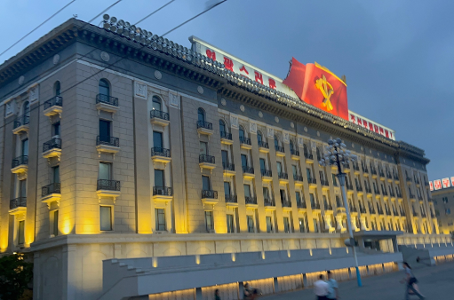
Our next activity was related to education, and to distance education too. We were taken to the teachers’ institute, which is located in the eastern part of the city. There are many universities in the eastern part of the city – it was noticeable by the large number of students on the streets we were travelling through. The students can be identified by their uniforms. All have white tops, grey bottoms. The girls – they can be so petite you could mistake them for pioneer girls – have short red ribbons tied around their necks instead of red ties. Young men are not in shorts like schoolchildren, but already in trousers.
There are more than 20 universities in Pyongyang. We were brought to the Pyongyang Teachers’ Institute. Here they train teachers for kindergarten and junior high schools. There is another institute, not a teacher’s institute, but a pedagogical institute, where they train middle school teachers. The Pyongyang Teachers’ Institute has several faculties, including social science, natural science, physical education and distance education. After high school, students study at the institute for three years, and then they can enroll for three more years in a master’s program. Or you cannot enter the institute but work for the benefit of the DPRK.
We drove up to the entrance in front of the football field, with typical portraits of two smiling leaders hanging over the canopy as usual.
The current leader of the Korean people visited the institution on 16 January 2018. In honor of this grand event, a museum room was set up in the institute. In the red corner under glass stood two chairs, on which Kim Jong-un sat – it is time for readers to already understand how honored the Grand Marshal is in the DPRK. Also, on the walls hung photos from that memorable date. The chairman in a long coat and a hat – it was not May outside – is walking along the corridors and in the offices of the university. Here he is carefully watching a 3D printer printing some plastic part. Here he is pointing at something. Kim Jong-un is developed in different spheres, and he has instructed to introduce 10 educational techniques – so we were told at the institute. He instructed us to implement his own techniques, according to Juche.
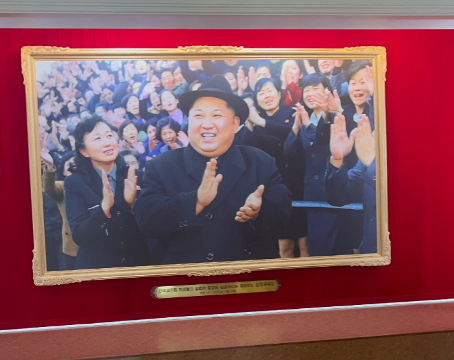
One of them is to teach children foreign languages from the age of 3, when the child’s brain can absorb and remember 90% of information. We ‘accidentally’ went to one class and were shown the results of this teaching. There were students sitting in the back of the classroom and students from the sponsored schools on the other desks. One student was teaching the class. Children learn Russian and English – the language of friends and enemies. Communication was conducted in English. The children were shown a screen with rows of 40 English words. In 30 seconds, these little blackheads had to memorize them, and in Russian they had to list them in the order in which the words were numbered.
The task, in my opinion, is impossible. Even for adults in their native language it is difficult to memorize 40 words in a row and for a long time.
Who’s ready? All the children raised their hands. For those adults who have been learning English all their lives, a screen with translation appeared. The student chose three girl-boy-girl.
– Grandma! Alphabet! Vegetables! – she blurted out with an accent through pauses, flexing her little fingers – White!! Trousers. Cake.
Shit, this is fantastic! What’s the catch?
She was replaced by a boy:
– Pencil! Skirt! A dog!
I felt like an underdeveloped dog. Although at school I was an excellent student, won at Olympiads, graduated from university and institute, the last one with a red diploma.
Then it was the second girl’s turn.
– Teacher!… Eight! Hare… Two… Nineteen! Uncle!
And the grey-haired uncle from Russia sat in the back row and didn’t understand a damn thing. How is this possible? Ai don’t know. I had no explanation for this phenomenon.
Then it was the other way round. In half a minute you had to memorise 40 words in Russian and speak in English. Again girl-boy-girl, and again phenomenal results. Are they raising Mozarts here?
Next, more!
40 numbers in two rows appeared on the screen. 40. And then, after 30 seconds of concentrated silence, the next trio demonstrated phenomenal memory. These are some kind of indigo children!
When we left, they sang us a song in Russian!
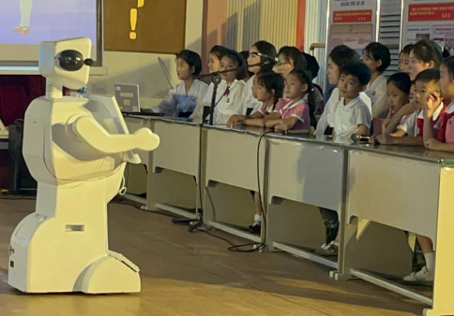
I asked the head of the university – they must have been looking for talent from the sponsored schools. No, she said they’re just ordinary kids. No, I understand, Juche and all that, but come on, these kids were definitely selected! I can’t believe it.
We were taken to the gymnasium, which was also an assembly hall with a stage. There were a bunch of people waiting for us, and not just people, but robots. Robots, white, on wheels, with a screen instead of faces, on their stomachs and backs, stood on the stage, there were a dozen of them, each with a Korean flag, each with a female student behind them – obviously they controlled them. A couple of the robots stood in the auditorium, the nearest bleachers of which were filled with students and children. We sat in an improvised presidium in front of the stage. A presenter from the stage opened the festivities and said that there would now be a demonstration of learning through music. A bass behind the curtain and a harmonica played, the music was lively, they were trying for us, though we were hardly worthy of the efforts of all these people. One robot moved and went twitching with its arms, followed by several children. They sang a song, the words of which appeared on the back of the cartoons at work. It was such an international musical medley non-stop – the songs changed, the languages changed – Korean, Chinese, Russian – the worker travelled back and forth, the children passed the microphones to each other. When the song in Russian ended, the robot obviously got confused, went to the exit and did not return. Oh, those Russians.
Then students sang for us, DPRK girls with flags danced in front of us, a robot with a flag came out. Honestly, we are not worthy, why did you have to go to such trouble. It was pleasant, of course, to hear the song “The favorite city can sleep in peace”, to this song, obviously from re-education, and returned the robot that left.
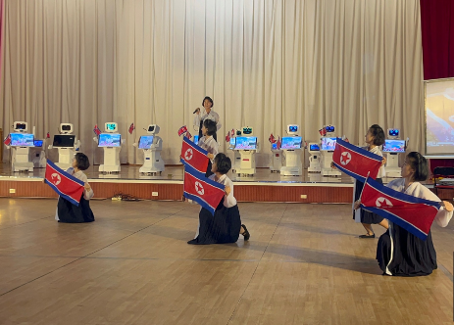
But at the institute they decided to finish us off. We were shown how children who are asked questions in different languages answer and look at the screen where two-digit numbers, negative and positive, appear, add them up in parallel in their minds, and at the end give the correct result. Then the girl sang a children’s song in Russian, memorizing twenty numbers in a row on the screen, and then listed them, wondering only how to pronounce the number six in Russian.
As the head of the institute explained to us later in the office, the right side of the brain is responsible for feelings and emotions and, for example, a song about Marshal Comrade Kim Jong-un helps children to memorize better.
After the performance – well, why did we have to strain such a lot of people! – we were led through the corridors and I noticed a poster with recommended, I guess recommended strongly, women’s and men’s haircuts. For female students it’s a bob of 4 different kinds, for young men the fringes are straight across the forehead or upwards. Remarkably, there are no slanted fringes, there are no angles, left or right.

I also noticed in one of the offices a children’s book with Mickey Mouse, Pluto and Donald Duck on it – North Korea may well use American images as well. North Korea does not pay for the use of these Disney cartoons, because of sanctions. It is forbidden even to supply children’s toys to Korea.
Then we were shown a humanoid female robot, which rolled down the corridor, as well as a teacher’s simulator, where future teachers and educators taught virtual children on the screen. I understood it was kind of like our Alice. You could talk to the virtual children, they answered questions. I suggested, of course, to ask whose Crimea is whose. After some pause, the answer came back, ‘Russian, of course!’ This caused our patriotic circles to laugh enthusiastically.
Watch our visit to the school including english-russian classes and robot dances in the following video link: https://dzen.ru/video/watch/670a5d643f6abd2101443acd?share_to=link
But that was not all the performances and wonders that awaited us. Because after the institute, we were taken to the North Korean circus.
The circus, like all iconic buildings and institution in the DPRK, is grandiose. It is a huge, rounded building made of glass and concrete. In front of the circus there is a whole square, buses are lined up in a row, from where the rows of Korean children in pioneer ties, girls – in pink dresses, boys – worms, black heads, as if they opened a jar of black caviar. I look at them with great interest, and they look at us, the big white giants, with great interest. Neither we nor they have seen each other live in such numbers. The boys shake hands gingerly; the girls bow habitually when you linger on them. The look. Manse. We are from the planet Moscow. Russia.
Inside, bronze statues of acrobats. In a glass cabinet near the wall, cups, bowls, statuettes, various prizes and awards are arranged on shelves. And the North Korean circus performers had and have something to be awarded for. The North Korean circus received its last award, the highest, a gold one, in Monaco.
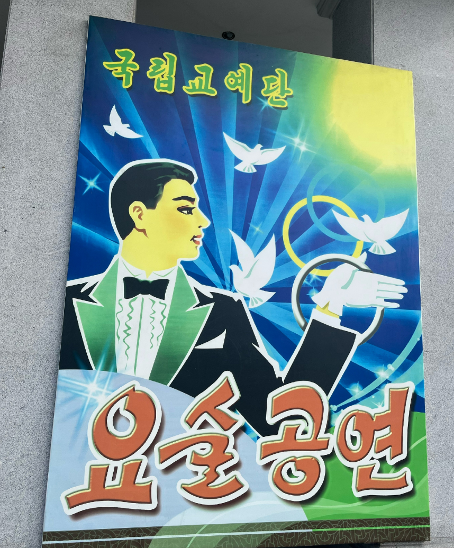
I did not enquire about the capacity, but I can say for sure that the Pyongyang Circus is not the Russian State Duma, outwardly it looked bigger than any concert hall, seats for half a stadium, no less, if not more. On our visit, the hall would be filled only God willing by a quarter. Everyone who didn’t get in then, and everyone who didn’t see the North Korean circus, lost a lot.
In the circus, of course, the government box for party officials and honoured guests. During the show, a live orchestra played on the dais. Above and below, soffits shimmered magically, soft, enchanting light. Yes, the light-music is outdated, you might say, but that’s the beauty of it. There are no cold lasers slicing the space, no unnatural computer sounds, everything is natural – live orchestra and soft spotlights. Just old-school.
Downstairs was not a stage, but a circular pool, with illuminated greenish water that wavered in anticipation, like a magic potion more often than not.
I can’t say that I’ve been to the circus often, I mostly caught it on TV, but I had a catharsis watching the show. It’s an art form! What the hell is the Cirque du Soleil! It’s absolute nonsense, and it’s not for nothing that Korean circus performers won the main prize in Monaco, as we were told later by our chaperones.
Circus in Korea is ascetic, no clowning and clowning, although there are some funny numbers. No illusions, all these tricks, only truth, only Juche, in North Korea they do not deceive. The basis of everything is acrobatic numbers.
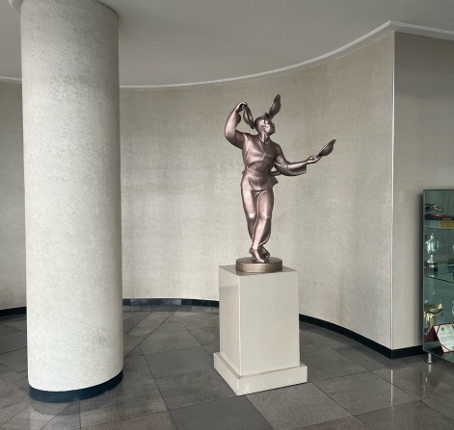
First the group performance in the pool. It was like synchronized swimming of the national team at the World Championships, class no less. Show with hoops – girls swimming in the circumference of the pool, twirling hoops with all parts of the body, legs and arms. Then the main girl – the star of the number – swam into the pool on a circular podium. Hoops began to be thrown at her. Three, five, then she caught her hand on the table and soared upwards without stopping spinning. By the end of the number, she was spinning all the hoops she had. That’s great.
Then there was the “fisherman” number. The girls pretended to be fish, and like a boat, a flexible young man sailed into the pool, the water swirled, and he pulled out a net one fish. It beat wriggling, bending, pulsating, then they soared upwards, and the “fish” began to perform acrobatic numbers with the net twirling, fluttering, splashes flew in all directions. That’s not enough! The fountains have started! A whole extravaganza of splashes, melody, light, bending bodies! Magnificent.
After a few water numbers, a platform came out, which covered the pool. On the platform two small figures, a girl and a boy, a beam of light picked out their puny figures. They began to perform acrobatics in the park. It was an incredible sight. Their bodies bent like plasticine as they connected and disconnected and froze like steel. What plastic! What impossible curves! It’s impossible, inexplicable! It’s beyond human body and strength. What graceful grace! The intertwining and tension of human muscles. And yet, performing unimaginable pirouettes, they smiled at the audience. Fantastic.
My recording of the circus performance in the following video link: https://dzen.ru/video/watch/670a875cf41c33483d768a8c?share_to=link
Then there were more numbers, simpler ones. The quintessence, the end and the apotheosis of the performance itself was the performance of acrobats, who under the dome, above the net stretched for safety, showed miracles of teamwork, swinging, twisting and jumping in the air, moving each other from one end to the other.
That’s how the whole of North Korea in monstrous tension at the cost of incredible efforts makes desperate beautiful pirouettes, twists and figures, interlocking into multicomposed human characters. In doing so, Koreans don’t forget to smile.
It’s a pity the whole world can’t see those smiles.
To be continued…
This article was previously published in Russian here. Translation to English by UWI.

















Leave a Reply